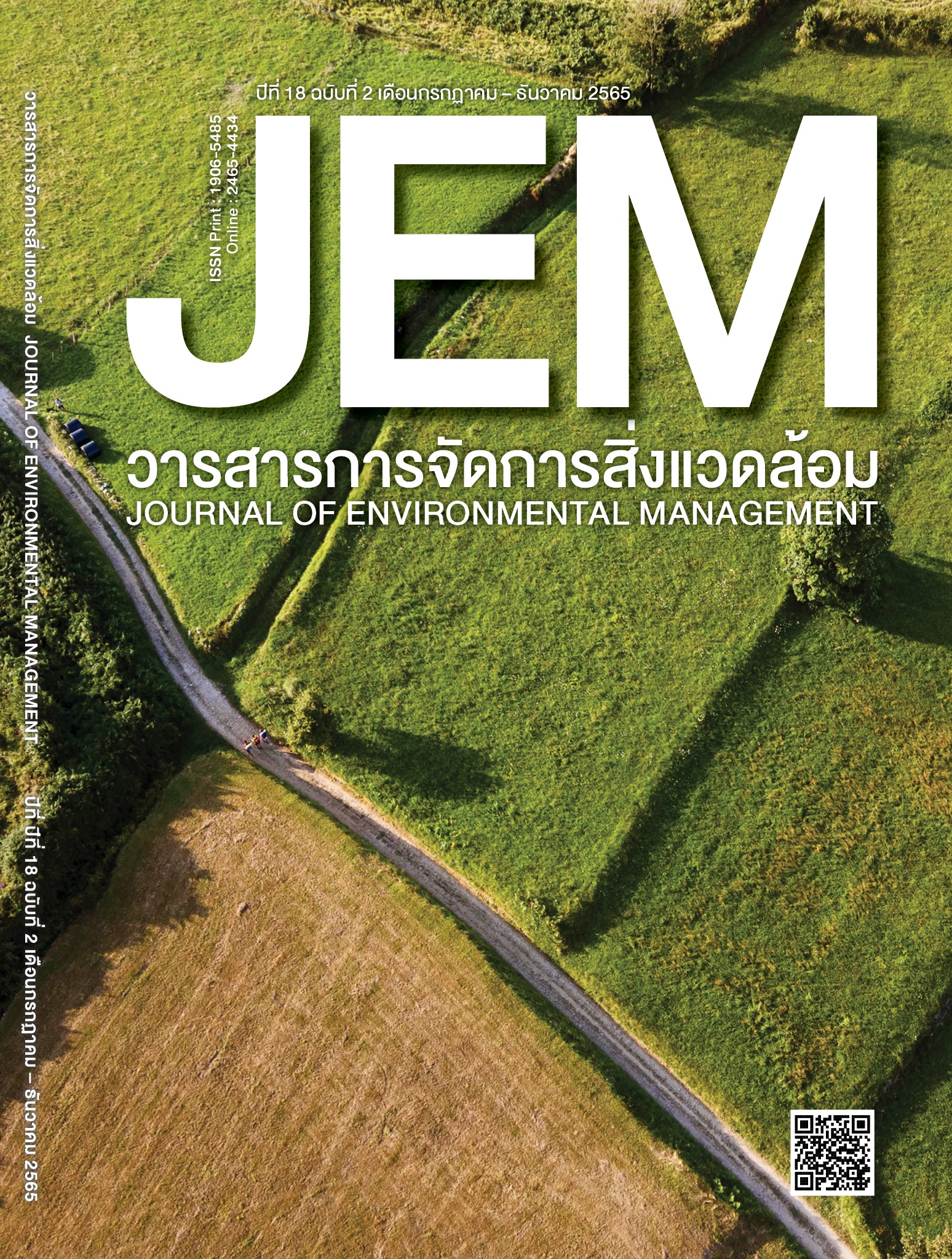สภาพปัจจุบันและสภาพที่พึงประสงค์ของการพัฒนาโรงเรียนสิ่งแวดล้อมศึกษา เพื่อการพัฒนาที่ยั่งยืน สังกัดสำนักงานเขตพื้นที่การศึกษามัธยมศึกษากรุงเทพมหานคร เขต 2
DOI:
https://doi.org/10.14456/jem.2022.12คำสำคัญ:
โรงเรียนสิ่งแวดล้อมศึกษา, การพัฒนาที่ยั่งยืน, มัธยมศึกษาบทคัดย่อ
การวิจัยครั้งนี้มีวัตถุประสงค์เพื่อ 1) เพื่อศึกษาสภาพปัจจุบันและสภาพที่พึงประสงค์ของการพัฒนาโรงเรียนสิ่งแวดล้อมศึกษาเพื่อการพัฒนาที่ยั่งยืน 2) เพื่อศึกษาความต้องการจำเป็นของการพัฒนาโรงเรียนสิ่งแวดล้อมศึกษาเพื่อการพัฒนาที่ยั่งยืน และ 3) เพื่อศึกษาแนวทางการพัฒนาโรงเรียนสิ่งแวดล้อมศึกษาเพื่อการพัฒนาที่ยั่งยืน สังกัดสำนักงานเขตพื้นที่การศึกษามัธยมศึกษากรุงเทพมหานคร เขต 2 รูปแบบการวิจัยแบบผสมผสาน กลุ่มตัวอย่าง คือ คณะกรรมการโรงเรียนสิ่งแวดล้อมศึกษาเพื่อการพัฒนาที่ยั่งยืน สุ่มกลุ่มตัวอย่างแบบง่าย จำนวน 226 คน และ ผู้ทรงคุณวุฒิจำนวน 9 คน เครื่องมือที่ใช้ในการวิจัย ประกอบด้วย แบบสอบถามและแบบสนทนากลุ่ม วิเคราะห์ข้อมูลโดยใช้ร้อยละ ค่าเฉลี่ย ส่วนเบี่ยงเบนมาตรฐาน และข้อมูลเชิงพรรณนา ผลการวิจัยพบว่า 1) สภาพปัจจุบันของการพัฒนาโรงเรียนสิ่งแวดล้อมศึกษาเพื่อการพัฒนาที่ยั่งยืน โดยภาพรวมอยู่ในระดับ ปานกลาง และ สภาพที่พึงประสงค์ของการพัฒนาโรงเรียนสิ่งแวดล้อมศึกษาเพื่อการพัฒนาที่ยั่งยืน โดยภาพรวมอยู่ในระดับ มากที่สุด 2) การพัฒนาโรงเรียนสิ่งแวดล้อมศึกษาเพื่อการพัฒนาที่ยั่งยืน มีความต้องการจำเป็นในการพัฒนาด้านผลที่เกิดขึ้นกับผู้เรียนมากที่สุด และ 3) แนวทางการพัฒนาโรงเรียนสิ่งแวดล้อมศึกษาเพื่อการพัฒนาที่ยั่งยืน ประกอบด้วย ด้านการบริหารจัดการสิ่งแวดล้อมศึกษา ด้านหลักสูตรและกระบวนการจัดการเรียนรู้สิ่งแวดล้อม ด้านการจัดการทรัพยากรธรรมชาติและสิ่งแวดล้อมในโรงเรียน ด้านการมีส่วนร่วมและการสร้างเครือข่ายสิ่งแวดล้อมศึกษา ด้านผลที่เกิดขึ้นกับผู้เรียน
เอกสารอ้างอิง
Bureau of Educational Innovation Development. (2021). Guide to Benchmark Assessment Of Environmental Studies Schools for Sustainable Development. Retrieved 2 April 2022, from https://anyflip.com/homepage/ixbqr.
Bureau of Educational Innovation Development. (n.d.). School Guide to Environmental Studies Standards for Sustainable Development. Bangkok. Inter-Tech Printing Company.
Caiado, R. G. G., et al. (2018). A literature-based review on potentials and constraints in the implementation of the sustainable development goals. Journal of cleaner production, 198, 1276-1288.
Cronbach, L. J. (1970). Essentials of psychological testing, 3rd Ed., New York. Harper & Row.
Du, Y., et al. (2018). Direct and spillover effects of urbanization on PM2. 5 concentrations in
China's top three urban agglomerations. Journal of Cleaner Production, 190, 72-83.
Hill, M. K. (2020). Understanding environmental pollution. Cambridge University Press. Journal of Indian Association for Environmental Management (JIAEM), 40(1), 1-5.
Joongpan, C. & Putwattana, N. (2020). A study of how environmental education is organized in the School of Environmental Studies for Sustainable Development. (Eco–school): A case study of schools in Pathum Thani. Journal of Science, Technology and Learning Environment Research, 11(1), 115-130.
Kongsat, S. & Dharmawong, T. (2008). Query accuracy determination (IOC). Retrieved 2 April 2022, from http://mcu.ac.th/site/articlecontent_desc.php?article_id=656&articlegroup_id=146.2551.
Kowsurat, W. (2020). The Thai Parliament plays a role towards the Sustainable Development Goals. Retrieved 2 April 2022, from https://thaipublica.org.
Lade, S. J.; et al. (2020). Human impacts on planetary boundaries amplified by Earth system
interactions. Nature Sustainability, 3(2), 119-128.
Li, Q., et al. (2020). Consistency of global warming trends strengthened since 1880s. Science Bulletin, 65(20), 1709-1712.
Masawat, J., Pradubpetcharat, P., & Kaewmanee, J. (2019). Wastewater treatment from latex plant using fly ash from biomass power plant. Retrieved 2 April 2022, from https://wb.yru.ac.th/handle/yru/3658.
Ministry of Education, (2020). M.D. stands for online classes to fight COVID-19 "Schools stop, knowledge does not stop." Retrieved April 2, 2022, from https://www.moe.go.th/.
Miyamoto, M., & Takeuchi, K. (2019). Climate agreement and technology diffusion: Impact of the
Kyoto Protocol on international patent applications for renewable energy technologies. Energy Policy, 129, 1331-1338.
National Strategy Secretariat Office. (2018). National Strategy 2018–2037 (Brief). Retrieved 2 April 2022, from https://www.nesdc.go.th/.
Office of the Basic Education Commission. (2021). Guide to Benchmark Assessment Of Environmental Studies Schools for Sustainable Development. Bangkok. Inter-Tech Printing Company.
Office of the Education Council. (2017) Office of the Secretary-General of the Council on Education. National Education Plan 2017-2036. Bangkok. Graphic sweet peppers.
Office of the Education Council. (2017). National Education Plan 2017 -2036. Graphic sweet peppers.
Okajima, I., & Sako, T. (2019). Recycling fiber-reinforced plastic using supercritical acetone. Polymer Degradation and Stability, 163, 1-6.
Potipituk, C. (2019). Measures to promote the psyche Raising awareness of environmental management to become a sustainable low-carbon community. Journal of Community Research, 13(2), 1-14.
Praneetham, C. (2019). Cross-Cultural Competencies of International College Students in Tourism. Journal of Choppayom, 30(1), 25-34.
Puttikul, P. & Kulapichitr, U. (2017). Developing an environmentally studied pedagogical model based on evidence-based and location-based learning concepts to create environmentally responsible behaviors of kindergarten children. Journal of Education, 45(3), 109-124.
Sumit, M., & Kumar, V. (2020). Deforestation: Facts, Cause, Effects, And Control Strategies.
Sumneang, V., Turisoth, T. & Kingminghae, P. (2019). A model for enhancing the holistic well-being of the elderly. In northeastern nursing homes. Journal of the Great Chula Nakorn, 6(10), 6001-6016.
Thai Government Gazette, (2018) The National Education Act 1999 was amended (No. 2) 2002 and (No.3) 2010. Gazette. Volume 116, Part 75 A. p. 8.
Thai Government Gazette. (2018). National Strategy 2018 – 2037. Gazette. Vol. 135, No. 82, pp. 45-54.
The Secondary Educational Service Area Office Bangkok 2. (2021). Policies and focus of the Bangkok Secondary Education Area Office District 2 FY 2022 – 2023. Retrieved 2 April 2022, from https://www.sesao2.go.th/.
Thitikunakorn, A. & Xupravati, P. (2019). Development of educational management to promote green values for learners in Australia : A Comparable Analysis of Education Management in Thailand, Journal of Educational Management and Innovation, 2(2), 84-100.
Timoshenko, A., & Berman, M. (2017). The United Nations Environment Programme and the
United Nations Development Programme. In Greening international institutions (pp.38-54). Routledge.
Wongwanich, S. (2007). Research assesses the need for need. Bangkok: Chulalongkorn University Press.
Yamane, T. (1967). Statistics: An Introductory Analysis. 2nd Ed., New York. Harper & Row.



